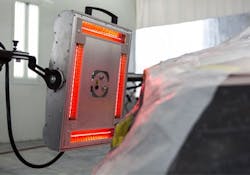Better Quality In No Time at All: Innovating Your Prep Area with Electric IR
By Jason Garfoot, Technical Advisor/Trainer, Global Finishing Solutions
As technology continues to improve, shops that adapt to new technology and processes are finding their painters and technicians can save ample time in productivity while also improving the quality of their work. One such technology recently finding its footing in North America is infrared curing technology. While gas-powered IR technology was introduced as an improvement over conventional curing systems, it is more recent developments in electric IR systems that solidify it as the future of the collision repair industry.
While electric IR has become best known for time savings and quality improvements in painting processes, we are increasingly finding that it is extremely adaptable and can increase productivity in many areas throughout a shop. If the paint booth is often thought of as the bottleneck of a shop, the prep area is equally so, as jobs take a long time to dry and impatience can lead to costly and even more time-consuming rework.
How it works
New systems such as Global Finishing Solutions’ REVO Accelerated Curing Systems use short-wave electric IR technology. This is generated by sending an electrical current to a tungsten filament, which then produces mostly short wave energy (tests indicate 80 percent of the energy emitted is short wave, with some medium waves as well).
The short wave energy is able to penetrate multiple layers of fillers and coatings to heat the substrate beneath, while the medium waves help cure the top layer. By heating the substrate, newer electric IR systems provide a complete cure by curing from the inside out. Many newer systems also feature intuitive controls that streamline the process for technicians.
As advancements in IR technology continue, systems are becoming even more adaptable. For example, GFS’ REVO Rapid MC2 and OR2 features two cassettes that can cure two different substrates at the same time with differing intensity depending on what is being cured. Electric IR systems come in many different models, from systems mounted on rails within a paint booth or prep area to more portable units that are on carts and even handheld. Many of these systems do not require a complete shop overhaul and work within a shop’s current footprint.
No longer a time-filler
It’s more than time savings, though; electric IR curing technology improves quality by correcting the behavior of adding too much hardener to the filler. In order to harden the filler quicker, technicians will often add much more hardener than they should, which ends up making the filler more brittle. By instead curing the filler with an IR system, it allows the technician to just use the recommended amount of hardener. This improves the quality of the end result, while also saving time.
Saving minutes on filler really adds up; this means technicians get to priming faster, where they can then save hours and days using electric IR.
A prime example
It has become commonplace for a high-production shop to let all of its vehicles in need of priming wait until the end of the day before getting primed. That way everything can dry overnight and be sanded in the morning. One problem with this process is that if a technician sands all the way through the primer, the process has to start all over again.
To counteract this, technicians are putting many coats of primer on to ensure they will not have to prime it again. This solves one problem while creating another: with too many layers, oftentimes the primer skims over the top and traps solvents underneath. The sanding process then opens up that primer unbeknownst to the painter, and after a couple of weeks of solvent slowly being released from the primer, the repaired area will stick out like a sore thumb (this is often referred to as edge mapping).
By saving significant time in the priming process, additional improvements can be made to quality; technicians no longer have to wait hours or overnight before potentially breaking through the primer while sanding, so they can take the time to prime properly. If they happen to make a mistake, it can be fixed in 15 minutes with the use of an electric IR system and they are sanding again.
Even if vehicles do start to pile up, IR can save the day. Imagine having a line of cars ready to be painted and discovering an issue with a car ready to be painted in the booth. Using a handheld IR unit, you can quickly prime a spot and dry it within minutes, rather than having to waste time shuffling things around to get the car out of the booth.
This has a large effect on overall shop throughput. No longer does a shop’s day need to be bookended by bottlenecks of priming and sanding. Instead, vehicles are primed when they are ready and sanded shortly after. Ultimately, shop flow becomes much more predictable and economical.
The IR difference
Electric IR systems can completely change how a shop operates. They are not just limited to filler, paint or primer, either. They are great for spot repairs, windshield removal, aluminum repair and more. It is technology that any shop looking to overhaul its throughput and improve the quality of their repairs should be looking into.
